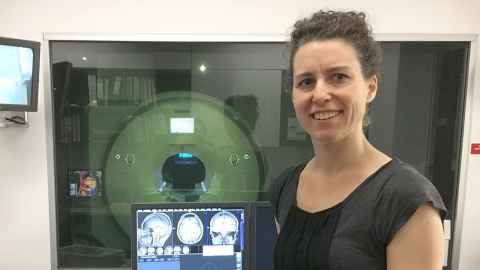New MRI method highlights the moving brain
30 May 2018
A new type of MRI method that shows clearer images of brain movement has the potential to help diagnose diseases earlier.

Amplified MRI (aMRI) was developed by University of Auckland academic Dr Samantha Holdsworth and her team. The results have just been published in Magnetic Resonance in Medicine.
The method magnifies the very small motions of the brain that occur due to force of blood going to the brain every time the heart beats.
Whilst in MRI (Magnetic Resonance Imaging) it is possible to capture a "movie” of the brain - a movie that captures several frames of the brain during one cardiac beat, it is difficult to see the motion of the brain because the image resolution is too low.
“The aMRI overcomes this because it is able to amplify sub-voxel motion, or motion that is smaller than the image resolution, using an image processing method. aMRI may allow us to detect pathological brain and vessel motion due to diseases or disorders that obstruct the brain or block the flow of brain fluid,” Dr Holdsworth says.
The resulting video images, reconstructed slice by slice, retain the spatial characteristics of an MRI — the skull and all anatomical features are displayed at actual scale — while magnifying pulse-driven motion significantly.
You can actually capture the whole head 'nodding' in the scanner due to the force of the blood pumping into the brain every time the heart beats.
"You can actually capture the whole head 'nodding' in the scanner due to the force of the blood pumping into the brain every time the heart beats. You can also see prominent motion in the mid-brain and spinal cord – as well as motion in the large vessels and other fluid in the brain."
The method may hold promise for a number of brain pathologies, and has already shown promise in the early diagnosis of Chiari Malformation (a condition in which brain tissue extends into the spinal canal). Other promising areas include those thought to increase the intracranial brain pressure such as hydrocephalous, a condition in which there is an accumulation of cerebrospinal fluid (CSF) within the brain.
This method uses technology from MIT which is used to amplify motion in real-world videos. The new aMRI method (called phase-based aMRI) is an improvement of the original aMRI method developed by Dr Holdsworth and Dr Mahdi Salmani Rahimi while she was based at Stanford University in California in 2016.
The image attached shows preliminary data in a normal control and a Chiari Malformation I patient (both who are 4-years old). The colour overlay shows increased and abnormal brain motion behaviour (red) in the Chiari Malformation I patient.
Phase-based aMRI was developed by Dr Holdsworth’s research assistant Itamar Terem at Stanford University through a University of Auckland—Stanford University—Stevens Institute of Technology collaboration. The new technology is even more impressive given that Dr Holdsworth mentored Itamar remotely from the University of Auckland for the last 10 months of the aMRI development, working around time differences as long distance colleagues.
Dr Holdsworth, Mr Terem, and Dr Mehmet Kurt from the Stevens Institute of Technology are working together to further develop aMRI. Since aMRI is able to pick up very small brain tissue motion, it may be possible to extract the biomechanical properties of the brain. This may be important for diseases that alter the stiffness of the brain such as neurodegenerative disease and traumatic brain injury.
"Better visualization and understanding of the biomechanical properties of the brain could also lead to better helmets," says Dr Kurt, a leading expert on biological dynamics and devices.
Dr Holdsworth says the technology is easily reproduced across MRI scanners.
Since aMRI is able to pick up very small vessel displacements, it also may have application to cerebrovascular disease. Dr Holdsworth will continue to develop the aMRI technology here at the University’s Faculty of Medical and Health Sciences, in collaboration with the Department of Anatomy and Medical Imaging, Centre for Brain Research, the Auckland Bioengineering Institute, the Stevens Institute of Technology, and Stanford University.
Papers
I Terem, WW Ni, M Goubran, M. Salmani Rahimi, G. Zaharchuk, KW Yeom, ME Moseley, M Kurt, S.J. Holdsworth. Revealing sub-voxel motions of brain tissue using phase-based amplified MRI (aMRI). Magnetic Resonance in Medicine (Being released, 2018).
S.J. Holdsworth, W. Ni, G. Zaharchuk, M. Rahimi, M. Moseley. Amplified Magnetic Resonance Imaging (aMRI), Magnetic Resonance in Medicine (2016).
Media enquiries:
Anna Kellett | Senior Media Advisor
Communications Office
Mob: +64 027 838 9202
Tel: +64 9 923 9336
Email: anna.kellett@auckland.ac.nz